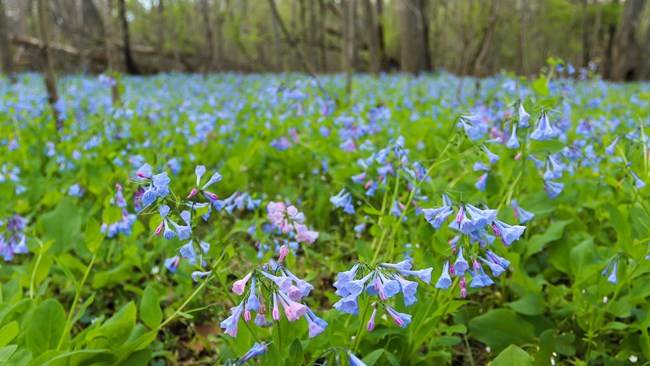Last updated: June 25, 2024
Article
View Virginia Bluebells and More at Bull Run Regional Park

Matt Felperin
There is arguably no wildflower that sparks more excitement in the Chesapeake Bay watershed than the Virginia bluebell (Mertensia virginica). Perhaps this is due to the rarity of the color blue in plants and animals, creating a sense of awe when seen in large numbers. While it has a wide range throughout eastern North America, there are some incredibly vast stands of these flowers in its namesake state of Virginia. One of the most impressive stretches of Virginia bluebells can be found at Bull Run Regional Park in Centreville, Virginia.
While peak bloom varies year to year, hiking the park’s 1.8 mile loop bluebell trail in the first two weeks of April should guarantee you plenty of blooming Virginia bluebells carpeting the floodplains of Cub Run and Bull Run. As their leaves emerge from the soil in March, they show a deep shade of purple, turning green prior to flowering. Varying in shades of blue, the blooms always start as pink buds. As the buds bloom, changes in the cellular pH cause them to become blue. Similar to hydrangeas, the mature flowers can range from blue to the less common pink depending on the soil acidity. Even more rare are the white blooms, which unlike the blue and pink, start as white buds. In addition to the bluebells, you can find a variety of gorgeous spring ephemerals along the bluebell trail including Virginia springbeauty (Claytonia virginica), cutleaf toothwort (Cardamine concatenata) and yellow trout-lily (Erythronium americanum). While not considered a spring ephemeral, the burgundy flowers of the paw-paw tree (Asimina triloba) lining the trail are also nice to look at.
In addition to the stunning blooms at Bull Run Regional Park, the extensive floodplains of Cub Run and Bull Run provide a highly-productive habitat for several unique species of birds and amphibians due to the inundated forest floor. Red-headed woodpeckers and rusty blackbirds are uncommon species of birds that are attracted to swamps and flooded forests, and both species can be reliably found during bluebell season. Towards the end of peak bloom, it is possible to observe early neotropical migrants such as northern parulas, prothonotary warblers, and yellow-throated warblers. On mild, wet nights in early March, there is a wonderful symphony of spring peepers, upland chorus frogs, wood frogs and American toads searching for a mate. Two species of mole salamanders, the spotted salamander and marbled salamander, are also found breeding here.
Bull Run Regional Park is open sunrise to sunset. Sunrise is the best time to experience the magic of the bluebell trail with the early morning light splashing on the blooms and the lack of crowds that start to fill the trail by mid-morning. Overcast skies provide the best conditions for photography and prevent the sun from washing out the color of the flowers. Rustic cabins and campsites are available to reserve with close access to the bluebell trail. Guided walks and photography workshops for the Virginia Bluebells, in addition to several other agency-wide programs, can be booked publicly or privately with the NOVA Parks roving naturalist.
This is an abridged article originally written by Matt Felperin.
